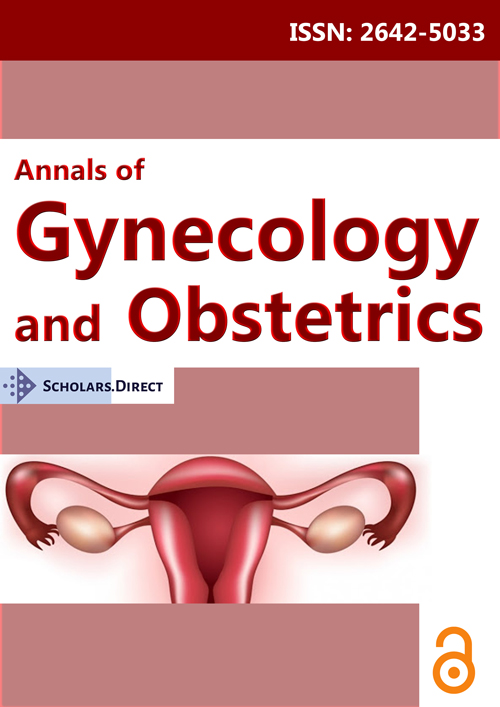Non-Obliterative Modified LeFort Colpocleisis with Retained Uterus
Abstract
Introduction and hypothesis : We present a surgical procedure for total prolapse that describes the technical considerations for performing a non-obliterative modified LeFort colpocleisis with retained uterus.
Method : For non-obliterative modified colpocleisis, resection of excess vaginal skin is performed, followed by amputation of the cervix. Repositioning of the uterus is accomplished by approximating the anterior and posterior vaginal wall with a row of horizontal sutures. A generous modified perineoplasty increases vaginal length, reduces the width of the hiatus and thus stabilizes the anatomical result.
Results : The procedure was performed in an 84-year-old woman with stage IV total prolapse. Preoperative ultrasound had revealed a small uterus with flat endometrial lining. There were no peri-operative complications. The patient recovered well postoperatively, without recurrent prolapse and/or stress incontinence during 6 months of follow-up. Her satisfaction with the postoperative result was excellent.
Conclusions : Our technique results in a vagina of normal length and physiological mobility of the pelvic floor. Sexual activity including vaginal penetration remains possible. The anatomy of the bladder and urethra are restored.
Keywords
Pelvic organ prolapse, LeFort colpocleisis, Vaginal preservation
Introduction
According to a study on postmenopausal women by the Women Health’s Initiative the prevalence of POP is around 40%, and due to the aging of the population globally, the prevalence is likely to increase [1]. The choice of treatment depends on the severity of prolapse and symptoms along with the patient’s individual health and activity status, as well as patient preferences. Current management includes observation, pelvic floor education, pessary use, and surgery.
In general, surgical treatment for prolapse has been categorized into reconstructive and obliterative procedures. Colpocleisis is a surgical treatment for pelvic organ prolapse commonly expected to result in vaginal obliteration. It traditionally aims at closing the vaginal canal to prevent the prolapse. The reported rate of POP recurrence after LeFort partial colpocleisis is 4.2% [2]. It was first described in the 19 th century and has mainly been reserved for frail or elderly women with medical comorbidities who no longer desire sexual intercourse [3].
Published studies have shown that obliterative procedures, when compared with reconstructive procedures, have shorter operative times, lower blood loss, less morbidity, and quicker recovery [4]. The anatomical success rate is reported to be as high as 98% and the satisfaction rate up to 92% [5]. However, although the anatomical success rates are high, colpocleisis as an obliterative and irreversible surgical procedure can have a negative impact on patients’ QOL, regarding their body image, sexual functionality, and also may cause regret [6]. Obliterative surgery is thus preferentially offered to older patients who have no desire for sexual activity, minimizing the chances of regret. The mean age in a series of reviewed articles on colpocleisis was between 69 and 84-years-old [7].
The increasing age of the population and the growing demand for a definitive operative treatment among the elderly warrant practical surgical solutions with good acceptance. Since the use of alloplastic implants has been restricted in many countries, it is mandatory to offer mesh-free options. Moreover, it is important to achieve a stable result in elderly women to prevent the necessity of repeated surgery. It has been speculated that the main risk factors for recurrence after colpocleisis in women with severe pelvic organ prolapse are an increased postoperative vaginal length and a wide vaginal hiatus [8]. Here we describe our modified colpocleisis technique for POP as a non-obliterative procedure preserving sexual function and affording a stable result at the same time.
Case Presentation
An 84-year-old woman presented with total prolapse for > 1 year and recurring urinary infections. Examination revealed total vaginal prolapse POP-Q stage 4 with vaginal eversion. Vaginal ultrasound showed a small uterus with flat endometrium. The patient was informed about the option of mesh-free correction with modified colpocleisis and consented to the procedure.
Procedure:
1. General anaesthesia was applied via a laryngeal mask according to standard protocol.
2. A urinary catheter was introduced transurethrally.
3. Incision lines for removal of vaginal epithelium were drawn respecting enough vaginal epithelium to allow tension-free approximation of the anterior and posterior wall at the intended apex (Figure 1).
4. The excess vaginal epithelium was removed from the underlying connective tissue using monopolar needle dissection.
5. The cervix was amputated to reduce the prolapse and to allow for optimal adherence of the wound surfaces after reposition of the prolapse.
6. The prolapse was repositioned and the anterior and posterior vaginal walls were closed over the prolapse with a row of interrupted horizontal #1 vicryl sutures.
7. Two clamps were placed on the ventrolateral aspects of the genial hiatus before a diamond-shaped flap was removed. The vagina was narrowed by a non-interrupted #0 vicryl suture beginning at the midline and ending at the former nymph hymen.
8. The perineum was reconstructed using a series of interrupted #1 vicryl sutures, followed by closure of the skin with 2.0 vicryl (Figure 2).
9. Vaginal compression was applied by introducing gauze for 24 hours to prevent hematoma formation.
The operation time was 22 min, and the estimated blood loss was < 10 ml. A tension-free reconstruction was achieved preserving a vagina of sufficient length and width to allow intercourse if so desired. There were no intra- or postoperative complications. The urinary catheter was removed one day postoperatively. The patient was dismissed 3 days after surgery. There was no prolapse recurrence or SUI during 6 months of follow-up. Ultrasound examination showed the uterus as well as both bladder and urethra in physiologic anatomical position. The patient was very satisfied with the result.
Discussion
The case presented shows that non-obliterative modified colpocleisis offers the option of achieving a stable result without the loss of sexual function. Thus, the method is suitable for elderly women who present with total prolapse and who are at least ambiguous about the issue of obliterative surgery. Hysterectomy can be avoided provided the uterus is without pathology. This significantly reduces operating time and the risk of hysterectomy-associated complications. Amputating the cervix prevents secretion formation from cervical glands and reduces the volume of the prolapse. Following the procedure, the remaining uterus and the bladder are repositioned into their physiologic anatomical position. The result is tension-free and avoids the necessity of using any mesh material or anchor systems, thus presenting as a valuable solution in cases with total prolapse.
Following are some key points of the procedure.
1. The uterus can be preserved provided there is absence of uterine pathology.
2. Cervix amputation reduces the volume of the prolapse and helps to create a solid tissue plane to stabilize the vaginal vault. Secretion formation by cervical glands is avoided.
3. The defects of the three levels are simultaneously repaired.
4. The non-obliterative approach preserves sexual function.
5. The tension-free reposition of the uterus restores pelvic floor anatomy, including physiologic re-positioning of bladder and urethra.
6. If indicated, additional prolapse reduction can be achieved through classical purse string sutures place horizontally on the anterior and/or posterior wall.
Compliance with Ethical Standards
Conflicts of interest
The authors declare that they have no conflict of interest.
Consent
Written informed consent was obtained from the patient for publication of this video article and any accompanying images.
Acknowledgements
None.
References
- Hendrix SL, Clark A, Nygaard I, et al. (2002) Pelvic organ prolapse in the women’s health initiative: Gravity and gravidity. Am J Obstet Gynecol 186: 1160-1166.
- Mikos T, Chatzipanteli M, Grimbizis GF, et al. (2017) Enlightening the mechanisms of POP recurrence after LeFort colpocleisis. Case report and review. Int Urogynecol J 28: 971-978.
- Neimark M, Davila GW, Kopka SL (2003) Le Fort colpocleisis: A feasible treatment option for pelvic organ prolapse in the elderly woman. J Pelvic Med Surg 9: 83-89.
- De Lancey JO, Morley GW (1997) Total colpocleisis for vaginal eversion. Am J Obstet Gynecol 176: 1228-1232.
- Zebede S, Smith AL, Plowright LN, et al. (2013) Obliterative LeFort colpocleisis in a large group of elderly women. Obstet Gynecol 121: 279-284.
- Jelovsek JE, Barber MD (2006) Women seeking treatment for advanced pelvic organ prolapse have decreased body image and quality of life. Am J Obstet Gynecol 194: 1455-1461.
- Felder L, Heinzelmann-Schwarz V, Kavvadias T (2022) How does colpocleisis for pelvic organ prolapse in older women affect quality of life, body image, and sexuality? A critical review of the literature. Women’s Health 18: 17455057221111067.
- Krissi H, Aviram A, Eitan R, et al. (2015) Risk factors for recurrence after Le fort colpocleisis for severe pelvic organ prolapse in elderly women. Int J Surg 20: 75-79.
Corresponding Author
Dimitrios Bolovis, Department of Obstetrics and Gynecology, Klinikum Nuremberg, Prof. Ernst-Nathan-Str. 1, 90419, Nuremberg, Germany, Tel: +49-911-398-2222, Fax +49-911-398-3399.
Copyright
© 2024 Bolovis DI, et al. This is an open-access article distributed under the terms of the Creative Commons Attribution License, which permits unrestricted use, distribution, and reproduction in any medium, provided the original author and source are credited.






